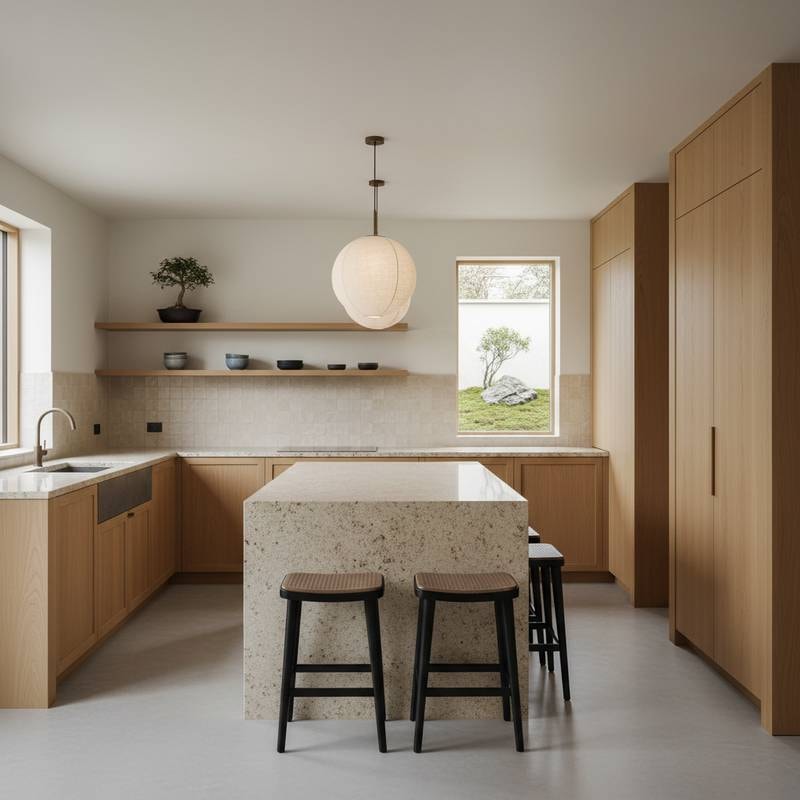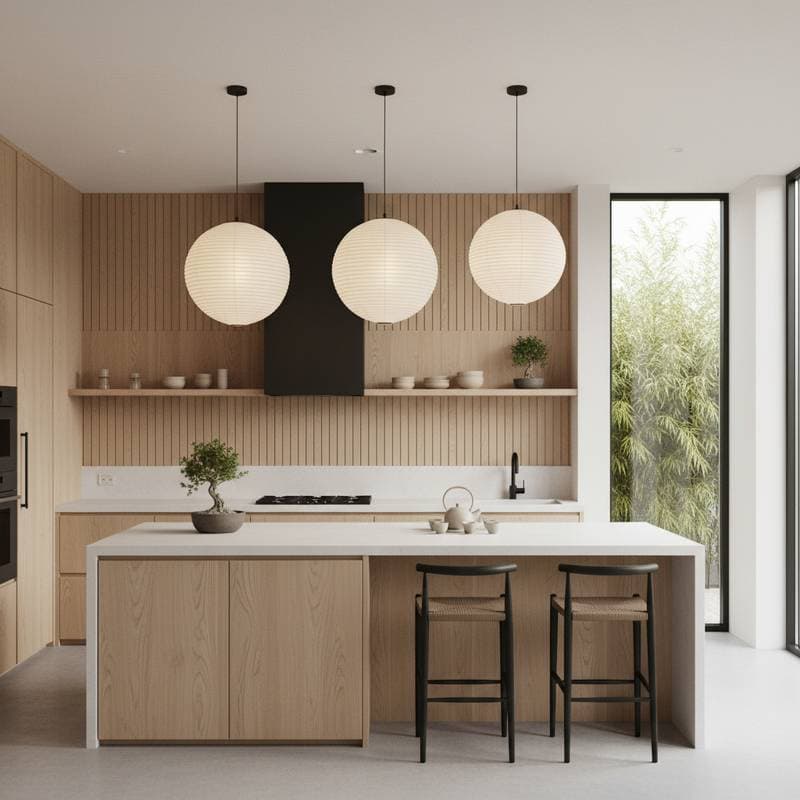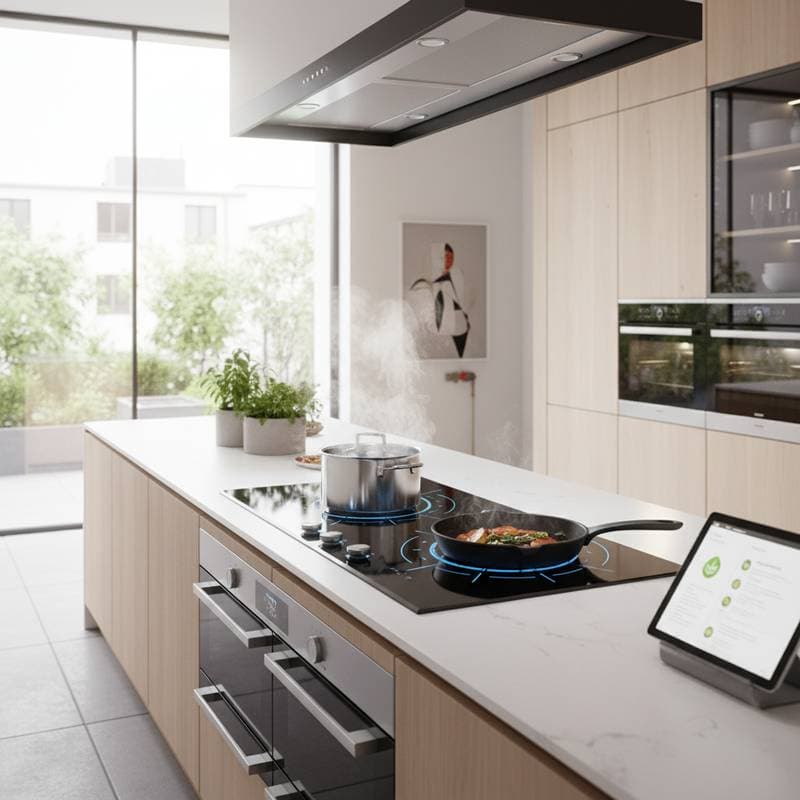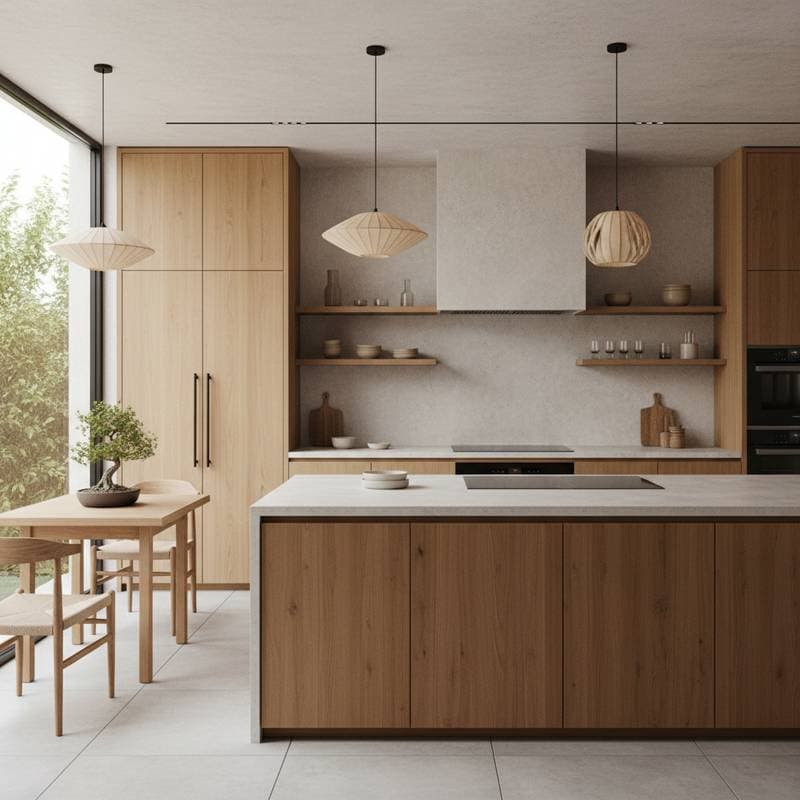Japandi Kitchens: Redefining Warm Minimalism
Homeowners seeking kitchen remodels frequently express a desire for spaces that are clean, serene, and enduring. Japandi design achieves this ideal by integrating the cozy essence of Scandinavian aesthetics with the disciplined simplicity of Japanese influences. The outcome is a kitchen that appears understated yet conveys profound comfort and individuality. This style demands meticulous planning and expert execution; success lies in selecting and applying elements with deliberate intent rather than mere reduction.
This guide examines the essential components of Japandi kitchens, identifies frequent errors to sidestep, and outlines practical considerations for incorporating the aesthetic into a home setting.
Foundations of Japandi Design
Japandi design prioritizes tranquil functionality, where each component serves a clear purpose. Natural substances form the base, clean profiles guide the forms, and the arrangement facilitates seamless daily activities.
Key characteristics of an authentic Japandi kitchen include:
-
Natural Materials
Selections such as wood, bamboo, stone, and clay provide the core structure. Pair light oak cabinetry with honed granite or soapstone countertops to achieve both inviting texture and lasting resilience. These choices develop a patina over time, enhancing character without requiring constant upkeep. -
Subdued Color Scheme
Employ gentle neutrals like beige, taupe, and inherent wood hues alongside crisp white or soft gray. Introduce subtle anchors, such as matte black fixtures or a deep-toned sink, to establish equilibrium without overwhelming the palette. -
Streamlined Functionality
Conceal storage solutions while ensuring effortless access. Opt for soft-closing drawers, built-in appliances that blend into cabinetry, and designs that minimize visible disorder. Prioritize configurations that promote fluid navigation and straightforward maintenance. -
Harmonious Illumination
Maximize daylight through expansive windows, roof apertures, or airy open shelving to allow the room to expand visually. Supplement with warm-toned LED fixtures during evenings, selecting bulbs that emit a gentle radiance rather than stark brightness. -
Artisanal Touches
Emphasize skilled workmanship through elements like bespoke wooden pulls, artisan-crafted ceramic tiles for the splash area, or exposed woodworking joints. These details convey thoughtful investment without ostentation.
Together, these features yield a kitchen that remains rooted and relevant, transcending passing fads.
Selecting Optimal Materials
Choices in materials determine the success of a Japandi kitchen, as they must evoke organic authenticity and stability.
Wood Choices
Opt for lighter varieties like oak, ash, or birch to capture Scandinavian lightness. Incorporate deeper options such as walnut or tinted bamboo for Japanese depth. A effective approach involves blending tones: lighter woods for primary cabinetry and richer shades for supplementary features like floating shelves or seating.
Countertop Options
Prefer matte or honed finishes to avoid glare. Materials like soapstone, limestone, or low-sheen quartz deliver a velvety tactile quality. Test samples for warmth under hand to confirm they align with the style's inviting nature.
Flooring Selections
Choose broad wooden planks or oversized porcelain tiles to maintain visual composure. Steer clear of intricate motifs that disrupt serenity. Subdued, textured natural stone serves as an alternative when installed in expansive formats.
Hardware Recommendations
Select slender profiles in matte black or satin brass to preserve sleek contours. Eschew bulky or decorative elements that draw undue attention. Hardware functions as a supportive accent, enhancing rather than overshadowing the overall composition.
Lighting Fixtures
Incorporate suspended lamps featuring rice paper or fabric diffusers for diffused, ambient light. Integrate slim under-cabinet strips for task illumination that integrates discreetly. Aim for bulb temperatures between 2700K and 3000K to replicate the soothing quality of natural sunset hues.
Managing Expenses and Excellence
Prospective remodelers often inquire about the affordability of Japandi kitchens. Costs vary based on material sourcing and construction quality, but strategic decisions enable accessibility without sacrificing integrity.
-
Prioritize Cabinet Construction
Cabinetry establishes the aesthetic foundation. Flat-panel fronts necessitate exact measurements and assembly; engage a specialist in fine joinery to prevent noticeable imperfections like uneven seams. -
Economize on Surface Treatments
Replicate premium stones affordably with engineered quartz that emulates organic veining and texture. Allocate budget toward enduring elements such as precision hardware and solid wood components. -
Focus on Durability
Inferior products may offer initial savings but degrade swiftly through warping or scratching. Japandi thrives on materials that mature elegantly; select those requiring simple periodic care over frequent substitutions. -
Simplify the Configuration
Additional bespoke elements inflate expenses unnecessarily. Maintain a straightforward floor plan, channeling resources into superior fabrication rather than elaborate additions.
Practical implementations on constrained budgets have proven effective by employing robust plywood cores, resilient synthetic overlays, and authentic wood edging. Balance remains the guiding principle.
Collaborating With Professionals
Engaging a contractor for a Japandi project requires clear dialogue, as the apparent simplicity conceals demands for accuracy.
-
Provide Visual References
Share high-quality images to synchronize visions. Nuances in shade or surface can alter outcomes dramatically, so multiple examples clarify preferences. -
Examine Physical Samples
Assess materials under home-specific lighting conditions. A hue appealing in artificial showroom light may shift to flatness in natural daylight. -
Inquire on Construction Techniques
Seamless cabinetry highlights any inconsistencies in edges or alignments. Request details on methods for achieving flush joints and uniform gaps. -
Account for Timelines
Bespoke fabrication and organic sourcing extend production phases. Incorporate buffers in project schedules to accommodate potential delays.
Professionals versed in contemporary or tailored millwork outperform those specialized in conventional installations.
Experiencing Daily Life in a Japandi Kitchen
After completion, the Japandi kitchen unfolds its advantages gradually, promoting relaxed habits. Preparing breakfast gains a sense of stability, while dinner preparation proceeds with reduced chaos. Organized storage lightens the load of everyday tasks.
Sustain this environment through:
- Daily surface cleaning and prompt item storage to prevent accumulation.
- Periodic exchange of modest decorative items aligned with seasons for subtle renewal.
- Annual application of protective oils or sealants to wood and stone elements.
- Vigilant oversight to resist gradual disorganization.
Preserving Long-Term Value
A Japandi kitchen represents an investment in serenity and superior construction. The selected materials, spatial organization, and execution details all contribute to a more composed lifestyle.
Approach decisions with deliberation to create a space that endures aesthetically and functionally for years. Favor enduring quality, rely on proficient artisans, and embrace simplicity infused with warmth. The outcome extends beyond visual appeal to deliver a truly restorative kitchen sanctuary.










